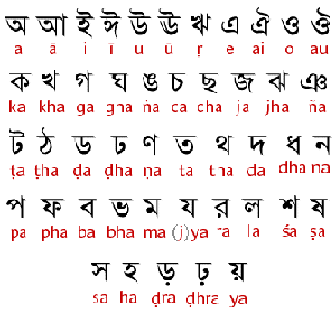By Sarah-Claire Jordan
 For foreigners and others not too familiar with the country of India, the Hindi language is maybe the only one that comes to mind when thinking about what languages the people of India speak. However, India is a land of a thousand languages, or at least over 120. Hindi may be the official language of India along with English, but there are large chunks of the population that speak languages that aren’t even part of the Hindi dialect continuum. One of those languages, which comes in at second place in terms of number of speakers, is Bengali.
For foreigners and others not too familiar with the country of India, the Hindi language is maybe the only one that comes to mind when thinking about what languages the people of India speak. However, India is a land of a thousand languages, or at least over 120. Hindi may be the official language of India along with English, but there are large chunks of the population that speak languages that aren’t even part of the Hindi dialect continuum. One of those languages, which comes in at second place in terms of number of speakers, is Bengali.
Bengali is the official language of Bangladesh and is native to the Bengal region, which is made up of Bangladesh as well as the Indian states of Tripura, West Bengal, and the southern region of Assam. About 250 million people speak Bengali as their native language, putting it in seventh place for the most spoken language in the world in terms of number of native speakers.
The Language of the Indian National Anthem
Though it may not be one of the official languages of India, Bengali is recognized as a regional official language in some Indian states. Along with that status, the national anthem of India, “Jana Gana Mana,” was actually originally written in Bengali by Rabindranath Tagore, a Nobel prize winning Bengali writer, poet, and composer. The lyrics were later translated into Hindi-Urdu by Abid Ali. Besides the national anthem of India, the Sri Lankan and Bangladeshi national anthems were all composed in Bengali originally.
Bengali as a Dialect Continuum
A dialect continuum is a group of dialects that form a spectrum, with dialects on either end of the spectrum that are so different that they are no longer mutually intelligible. Bengali is classified by linguists as a dialect continuum, just like Hindi. Besides that, the dialects of Bengali tend to be organized into four different groups: Varendra, Banga, Rarh, and Kamarupa. Not everyone agrees with this way of organizing the Bengali dialects, but it seems to be the most common way of doing so.
Tollywood: Bengali On Screen
Something very interesting about Bengali is that there is an entire film industry, nicknamed “Tollywood”, that makes films in Bengali. Tollywood dates back to the 1890s, way before Bollywood came into existence. In fact, the name “Bollywood” was inspired by Tollywood. Tollywood is based in Tollygunge in West Bengal, thus the name that combines “Hollywood” with Tollygunge. Many of the films that have come out of Tollywood have been nationally and internationally acclaimed, some even winning awards. They have had a great influence as well on the most well-known Indian film industry, Bollywood, as well as the film industry in general.
Bengali may seem like just a regular language, but as you can see it has a lot of importance and history in many countries, including India, Bangladesh, and Sri Lanka. It was, and still is, regarded as a literary language, with some of the best literature from India written in Bengali. Its film industry may have been the catalyst that created the empire that is now Bollywood, and it is only one of over 120 different languages spoken in India.
For an overview of our translation expertise, visit our telephone interpreting service page



